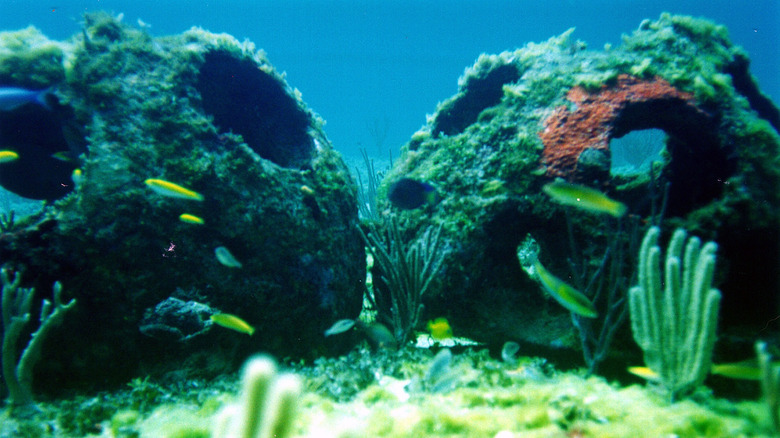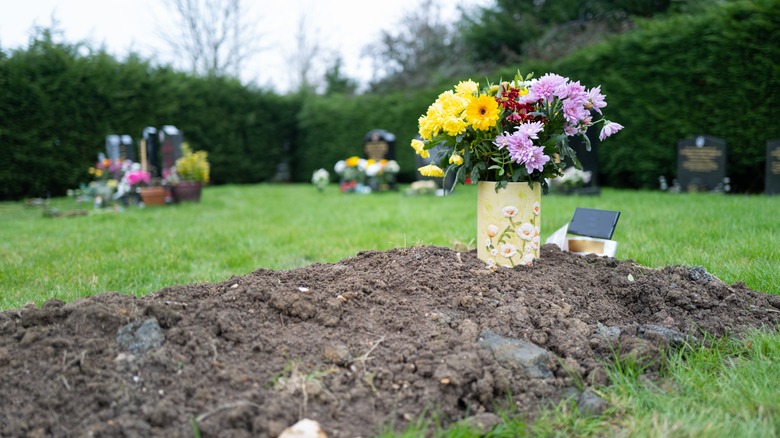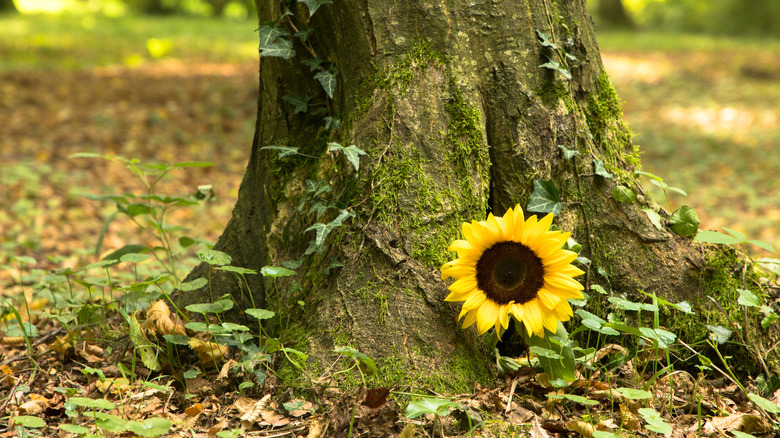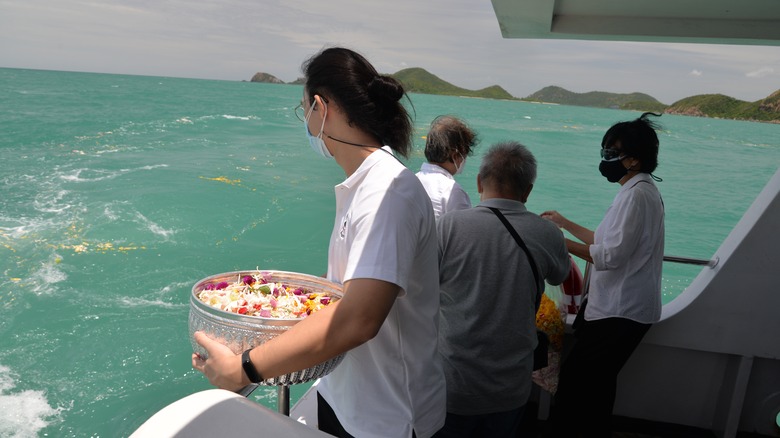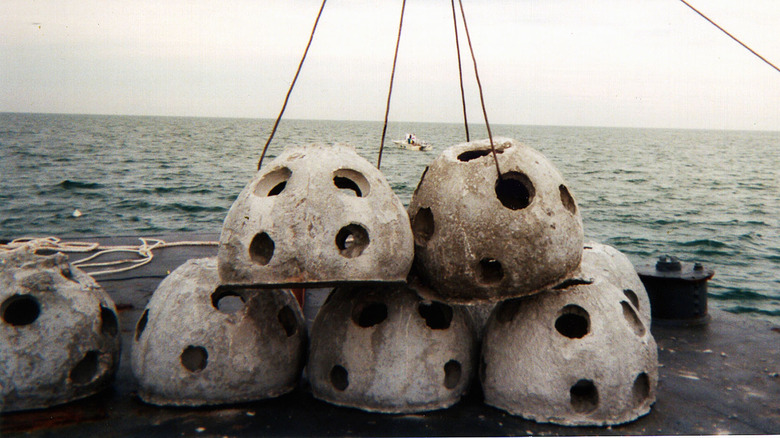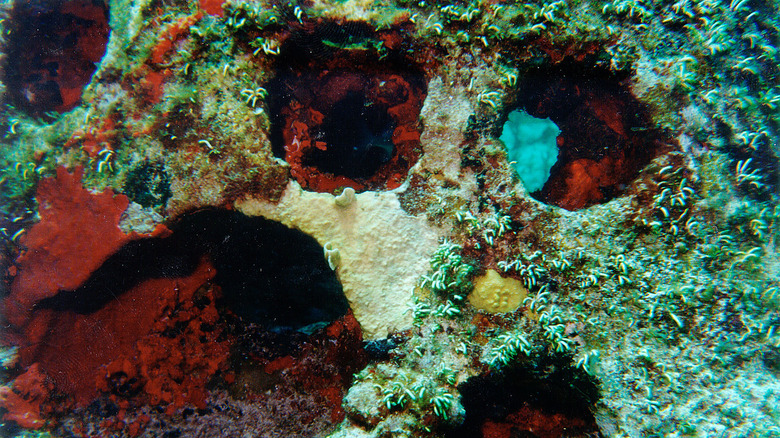The Reason One Florida Company Repurposes Dead Bodies For Environmental Use
With human beings globally emitting the highest rate of carbon emissions since the industrial revolution and people in the U.S. alone emitting some 5,000 million metric tons of carbon dioxide per year, people are finally catching on to the critical environmental impact we are having as a species on the planet (via Environmental Protection Agency). But while many people may be becoming more conscious of their carbon footprint in life, most are not aware of the carbon footprint they leave after death.
According to Smithsonian Magazine, people embalmed and buried by funeral parlors can seep toxic chemicals into the ground, contaminating drinking water. Cemeteries require lots of upkeep, including huge amounts of water to keep the grass fresh and fertilizer that can contain chemicals (via Smithsonian Magazine). And during the cremation process, many facilities release large amounts of carbon dioxide and mercury into the atmosphere, which add to our collective carbon footprint.
People are beginning to realize that our emissions don't stop after life ends. Some are stepping up to the plate to find more eco-friendly ways to deal with the remains of the deceased.
Green funerals
In 2016, Ramsey Creek Preserve — known as "the nation's first 'green cemetery'" — started a new form of funeral that reduces environmental impact, according to Smithsonian Magazine. Burying the dead without fancy embalming fluids has been an ancient practice that is still performed in rural communities around the world. The newly embraced idea is to allow a body to naturally decompose in the ground. Graves are "dug by hand," bodies are preserved with dry ice with no embalming fluid in sight, and there are no marble or granite headstones used (via Smithsonian Magazine).
It's part of a growing movement of "green funerals" that are trying to make the process of dealing with the remains of the deceased cheaper and more sustainable. Although some were initially worried that this form of burial could also pollute the groundwater, "it's not just digging holes, throwing bodies into them and walking away," the executive director of the Green Burial Council Kate Kalanick told Smithsonian. These new green burial facilities can be officially certified by Kalanick's company, which recommends bodies be packed in steel, wood, and concrete, to allow for a slow decomposition process that actually fertilizes the soil (via Smithsonian Magazine).
Tree burials
Some green burials capitalize on the fertilization potential of human remains. Recently, several companies have begun to offer services in which dead loved ones can be placed in biodegradable capsules that are then planted with tree seedlings. The idea is to have a new forest planted on a plot of land, where trees can absorb carbon in the atmosphere, instead of having a flat cemetery that needs lots of watering and is littered with tombstones (via CNN).
This type of burial is gaining particular popularity in light of the fact that burial space is growing more and more hard to come by. According to Forbes, many urban cemeteries in the U.S. are running out of room with no more land to expand, especially as the baby boomer generation begins to die. In other parts of the world like Hong Kong, cemeteries are one of the most expensive pieces of real estate you can buy, according to The Guardian. Although this idea is just now gaining popularity in the U.S., the idea of the tree burial, or "Jumokusō," has been a practiced funeral custom since the 1990s as a form of Buddhist burial in Japan (via Smithsonian Magazine).
Burials at sea
With the world running out of space to bury the dead on land, people are starting to dispose of the dead at sea in even more bizarre burials. Although many people have been cremated and had their ashes spread out in the ocean, this can still lead to emissions and toxins pumped out into the atmosphere when cremation facilities don't have the proper filtration systems in place. Like green burials on land, blue burials in the sea are cheaper than traditional burials in a cemetery and offer a more environmentally-friendly way to dispose of a body, according to the Los Angeles Times. However, despite these benefits, this method is still relatively rare, with one funeral director in California telling the Los Angeles Times that less than 1% of "burials he's facilitated in the past 32 years" took place at sea.
There are protocols in place to be buried at sea to make sure that dead bodies are not washing up on shore — the Environmental Protection Agency recommends bodies be wrapped in biodegradable fabric and weighted to make sure the body falls to the ocean floor, and that bodies are thrown into sea where the water is at least 600 feet deep.
Water Wiffle balls
One Florida company is taking the sea burial one step further. Instead of simply disposing of a body on the ocean floor, Eternal Reefs performs a process similar to the tree burials on land. But instead of using a corpse as fertilizer to grow a tree, the company uses a person's cremated remains to rebuild an artificial coral reef in parts of the world where the effects of climate change are destroying the ocean's bright and colorful reefs. According to National Geographic, "warming waters, pollution, ocean acidification, overfishing, and physical destruction are killing coral reefs around the world." That's important because coral reefs provide habitats for thousands of species, protect nearby beaches and shores from wave erosion, and provide lots of communities with a source of economic income related to tourism, per the National Oceanic and Atmospheric Administration.
Here's how it works: Eternal Reefs partners with families who want to incorporate their loved ones' remains in a coral reef for an epic funeral (via USA Today). They work together to mix the remains with a sort of concrete, where family members can put handprints or written notes to their loved ones. The mixture is made up of a pH-neutral concrete, with its weight distributed so that the reef maintains stability in a flowing ocean. The reef-cremation burial material ends up looking like a big Wiffle ball or a piece of circular Swiss cheese, for lots of fish, plants, and other organisms to hide in and make home.
Burials in a reef
The Eternal Reefs company was started by a pair of divers in the 1980s. After watching the environmental impact of climate change on coral reefs — with 14% of the world's reefs destroyed since 2009, per the Reef Resilience Network — two college roommates at the University of Georgia who were diving off the coast of Florida decided to do something to restore them. As of May 2021, "2,500 Eternal Reefs have been placed off the coasts of Florida, Maryland, New Jersey, North Carolina, South Carolina, Texas and Virginia," with a particular uptick in business during the COVID-19 pandemic, according to USA Today.
Many people have created artificial reefs across the globe to try and restore the natural phenomenon and reduce erosion on the world's beaches, according to New Heaven Reef Conservation. For example, Singapore is using Legos to rebuild their coral reefs. Just like the tree burials, it's not a bad way to go. Quite a legacy to have death become a new form of life.
